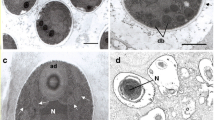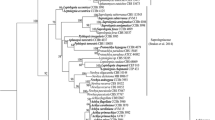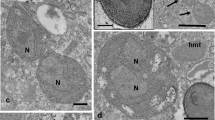Abstract
Recent studies showed that the huge diversity branching at or near the phylogenetic root of the fungal kingdom, mostly constituted by uncultured environmental clones, is actually characterized by intracellular predators/parasites of various eukaryotes. These form three related lineages: the Aphelidea, endoparasites of algae; the Rozellomycota, with Rozella species mainly endoparasites of water moulds, and Paramicrosporidium species endonuclear parasites of amoebae; and the Microsporidia, mainly endoparasites of animals. Increasing evidence suggests the emergence of Microsporidia from within Rozellomycota; however, their fungal or protistan nature is still unclear. Here, we report the molecular phylogeny based on the small subunit ribosomal RNA (SSU rDNA) gene, of an additional endoparasite of amoebae, corresponding to the old enigmatic chytrid Nucleophaga amoebae described in the nineteenth century. Our results show that Nucleophaga, possessing a morphotype intermediate between Rozella and Paramicrosporidium, emerges as a unique lineage within the Rozellomycota. The recovery and characterization of new members of Rozellomycota are of high value for the understanding of the early evolutionary history of the Fungi and related lineages.


Similar content being viewed by others
References
Anderson SA, Stewart A, Tolich Allen G (1995) Pseudosphaerita euglenae, a fungal parasite of Euglena spp. in the Mangere Oxidation Ponds, Auckland, New Zealand. N Z J Mar Freshw Res 29:371–379
Atsatt PR, Whiteside MD (2014) Novel symbiotic protoplasts formed by endophytic fungi explain their hidden existence, lifestyle switching, and diversity within the Plant Kingdom. PLoS ONE 9:e95266
Brumpt E, Lavier G (1935) Sur une nucléophaga parasite d’Endolimax nana. Ann Parasitol Hum Comp 13:439–444
Cavalier-Smith T (1987) The origin of fungi and pseudofungi. In: Rayner ADM, Braiser CM, Moore D (eds) Evolutionary biology of Fungi. Cambridge University Press, Cambridge, pp 339–353
Cavalier-Smith T (2013) Early evolution of eukaryote feeding modes, cell structural diversity, and classification of the protozoan phyla Loukozoa, Sulcozoa, and Choanozoa. Eur J Protistol 49:115–178
Corradi N, Keeling PJ (2014) Ecological genomics of the microsporidia. In: Martin F (ed) The ecological genomics of fungi. John Wiley & Sons, Inc, pp 261–278
Corsaro D, Walochnik J, Venditti D, Steinmann J, Müller K-H, Michel R (2014) Microsporidia-like parasites of amoebae belong to the early fungal lineage Rozellomycota. Parasitol Res 113:1909–1918
Dangeard P-A (1895) Mémoire sur les parasites du noyau et du protoplasme. Le Botaniste 4:199–248
Gutman J, Zarka A, Boussiba S (2009) The host-range of Paraphysoderma sedebokerensis, a chytrid that infects Haematococcus pluvialis. Eur J Phycol 44:509–514
Held AA (1981) Rozella and Rozellopsis: naked endoparasitic fungi which dress-up as their hosts. Bot Rev 47:451–515
Hoffman Y, Aflalo C, Zarka A, Gutman J, James TY, Boussiba S (2008) Isolation and characterization of a novel chytrid species (phylum Blastocladiomycota) parasitic on the green alga Haematococcus. Mycol Res 111:70–81
James TY, Berbee ML (2012) No jacket required—new fungal lineage defies dress code: recently described zoosporic fungi lack a cell wall during trophic phase. Bioessays 34:94–102
James TY, Kauff F, Schoch CL, Matheny PB, Hofstetter V, Cox CJ, Celio G, Gueidan C, Fraker E, Miadlikowska J, Lumbsch HT, Rauhut A, Reeb V, Arnold AE, Amtoft A, Stajich JE, Hosaka K, Sung GH, Johnson D, O’Rourke B, Crockett M, Binder M, Curtis JM, Slot JC, Wang Z, Wilson AW, Schüssler A, Longcore JE, O’Donnell K, Mozley-Standridge S, Porter D, Letcher PM, Powell MJ, Taylor JW, White MM, Griffith GW, Davies DR, Humber RA, Morton JB, Sugiyama J, Rossman AY, Rogers JD, Pfister DH, Hewitt D, Hansen K, Hambleton S, Shoemaker RA, Kohlmeyer J, Volkmann-Kohlmeyer B, Spotts RA, Serdani M, Crous PW, Hughes KW, Matsuura K, Langer E, Langer G, Untereiner WA, Lücking R, Büdel B, Geiser DM, Aptroot A, Diederich P, Schmitt I, Schultz M, Yahr R, Hibbett DS, Lutzoni F, McLaughlin DJ, Spatafora JW, Vilgalys R (2006) Reconstructing the early evolution of Fungi using a six-gene phylogeny. Nature 443:818–822
James TY, Pelin A, Bonen L, Ahrendt S, Sain S, Corradi N, Stajich JE (2013) Shared signatures of parasitism and phylogenomics unite Cryptomycota and Microsporidia. Curr Biol 23:1548–1553
Johnson PTJ, Longcore JE, Stanton DE, Carnegie RB, Shields JD, Preu ER (2006) Chytrid infections of Daphnia pulicaria: development, ecology, pathology and phylogeny of Polycaryum laeve. Freshw Biol 51:634–648
Jones MDM, Forn I, Gadelha C, Egan MJ, Bass D, Massana R, Richards TA (2011) Discovery of novel intermediate forms redefines the fungal tree of life. Nature 474:200–203
Karling JS (1972) The present status of Sphaerita, Pseudosphaerita, Morella and Nucleophaga. Bull Torrey Bot Club 99:223–228
Karpov SA, Mikhailov KV, Mirzaeva GS, Mirabdullaev IM, Mamkaeva KA, Titova NN, Aleoshin VV (2013) Obligately phagotrophic aphelids turned out to branch with the earliest-diverging fungi. Protist 164:195–205
Karpov SA, Mamkaeva MA, Aleoshin VV, Nassonova E, Lilje O, Gleason FH (2014a) Morphology, phylogeny, and ecology of the aphelids (Aphelidea, Opisthokonta) and proposal for the new superphylum Opisthosporidia. Front Microbiol 5:112
Karpov SA, Mamkaeva MA, Benzerara K, Moreira D, López-García P (2014b) Molecular phylogeny and ultrastructure of Aphelidium aff. melosirae (Aphelida, Opisthosporidia). Protist 165:512–526
Kirby H (1927) Studies on some amoebae from the termite Mirotermes, with notes on some other Protozoa from the Termitidae. Q J Microsc Soc 71:189–222
Lara E, Moreira D, López-García P (2010) The environmental clade LKM11 and Rozella form the deepest branching clade of Fungi. Protist 161:116–121
Lavier G (1935) Sur une Nucleophaga parasite d'Entamoeba ranarum. Ann Parasitol Hum Comp 13:351–361
Letcher PM, Lopez S, Schmieder R, Lee PA, Behnke C, Powell MJ, McBride RC (2013) Characterization of Amoeboaphelidium protococcarum, an algal parasite new to the cryptomycota isolated from an outdoor algal pond used for the production of biofuel. PLoS ONE 8:e56232
Medlin L, Elwood HJ, Stickel S, Sogin ML (1988) The characterization of enzymatically amplified eukaryotic 16S-like rRNA coding regions. Gene 71:491–499
Mercier L (1910) Contribution à 1'étude de l'amibe de la blatte (Entamoeba blattae Bütschli). Arch Protistenkd 20:143–175
Michel R, Schmid EN, Böker T, Hager DG, Müller K-D, Hoffmann R, Seitz HM (2000) Vannella sp. harboring Microsporidia-like organisms isolated from the contact lens and inflamed eye of a female keratitis patient. Parasitol Res 86:514–520
Michel R, Müller K-D, Hauröder B (2009a) A novel microsporidian endoparasite replicating within the nucleus of Saccamoeba limax isolated from a pond. Endocytobios Cell Res 19:120–126
Michel R, Hauröder B, Zöller L (2009b) Isolation of the amoeba Thecamoeba quadrilineata harbouring intranuclear spore forming endoparasites considered as fungus-like organisms. Acta Protozool 48:41–49
Palenzuela O, Redondo MJ, Cali A, Takvorian PM, Alonso-Naveiro M, Alvarez-Pellitero P, Sitjà-Bobadilla A (2014) A new intranuclear microsporidium, Enterospora nucleophila n. sp., causing an emaciative syndrome in a piscine host (Sparus aurata), prompts the redescription of the family Enterocytozoonidae. Int J Parasitol 44:189–203
Powell MJ (1981) Zoospore structure of the mycoparasitic chytrid Caulochytrium protostelioides Olive. Am J Bot 68:1074–1089
Powell MJ (1984) Fine structure of the unwalled thallus of Rozella polyphagi in its host Polyphagus euglenae. Mycologia 76:1039–1048
Sebé-Pedrós A, Burkhardt P, Sánchez-Pons N, Fairclough SR, Lang BF, King N, Ruiz-Trillo I (2013) Insights into the origin of metazoan filopodia and microvilli. Mol Biol Evol 30:2013–2023
Sparrow FK Jr (1960) Aquatic phycomycetes, 2nd edn. The University of Michigan Press, Ann Arbor
Upton SJ, Brillhart DB, McAllister CT (1991) Two morphologically distinct types of Giardia sp. occur in cotton rats, Sigmodon hispidus. Tex J Sci 43:373–376
Voge M, Kessel JF (1958) Sphaerita in cysts of Entamoeba coli. J Parasitol 44:454–455
Acknowledgments
We thank R. Kurek for the assistance and previous microscopy data. This study was supported by internal fundings of each laboratory.
Author information
Authors and Affiliations
Corresponding author
Electronic supplementary material
Below is the link to the electronic supplementary material.
Supplementary Figure 1
Maximum-Likelihood 18S rDNA tree of Fungi, other opisthokonts (Animalia and Choanozoa), Apusozoa and Amoebozoa, the latter used as root. Full tree topology is shown for the Rozellomycota, to demonstrate the relative position of the three cultured genus-level taxa (in bold) identified in this group. Other major groups are collapsed (see Suppl. Table 1). Branchs are shortened to 1/2 (Thecamonas, Dictyostelium) or 1/3 (Entamoeba). Bootstrap values >50 % are indicated (1000 replicates). (PDF 209 kb)
Supplementary Table 1
List of taxon names and GenBank accession numbers used in this study. (XLS 35 kb)
Rights and permissions
About this article
Cite this article
Corsaro, D., Walochnik, J., Venditti, D. et al. Rediscovery of Nucleophaga amoebae, a novel member of the Rozellomycota. Parasitol Res 113, 4491–4498 (2014). https://doi.org/10.1007/s00436-014-4138-8
Received:
Accepted:
Published:
Issue Date:
DOI: https://doi.org/10.1007/s00436-014-4138-8




